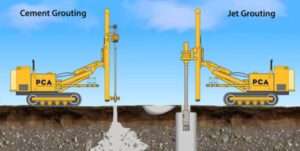As infrastructure projects expand and environmental changes alter natural landscapes, the need for reliable slope stabilization solutions has never been greater. Slope failures, caused by factors such as heavy rainfall, soil erosion, seismic activity, or human activities, pose significant risks to infrastructure, property, and public safety. Fortunately, advancements in engineering techniques and materials are transforming how we address these challenges. This article explores some of the most innovative solutions for slope stabilization and the materials driving their success.
1.Geosynthetics for Slope Reinforcement
Geosynthetics, including geotextiles, geogrids, and geomembranes, are widely recognized for their ability to stabilize slopes and control erosion.
- Geogrids enhance the mechanical properties of soil by reinforcing weak layers and improving load-bearing capacity.
- Geotextiles provide filtration, drainage, and separation, reducing the risk of water-induced slope failures.
- Geomats (or erosion control mats) protect slopes from surface erosion by holding soil particles in place while allowing vegetation growth.
These materials are cost-effective, lightweight, and easy to install, making them ideal for both natural and engineered slopes.
2.Soil Nailing and Anchoring Systems
Soil nailing is a proven technique for stabilizing slopes, excavations, and retaining walls. It involves inserting steel bars or nails into the slope at predetermined angles, which are then grouted into place for added stability.
Key benefits:
- Flexibility to adapt to various slope geometries
- Minimal disruption to existing landscapes
- Cost-efficiency compared to conventional retaining walls
In more challenging conditions, ground anchors, such as tensioned steel cables, provide deep-seated stabilization by anchoring the slope to more stable rock or soil layers.
3.Vegetation and Bioengineering Methods
Combining nature with engineering, bioengineering solutions leverage plants and organic materials to stabilize slopes while maintaining ecological balance. Techniques include:
- Hydroseeding: Spraying a mixture of seeds, mulch, and soil stabilizers to promote rapid vegetation growth.
- Live staking and brush layering: Using live plant materials to reinforce soil while fostering root systems that bind the ground.
- Coir mats and biodegradable blankets: Providing temporary erosion control until vegetation is established.
These eco-friendly approaches are increasingly favored for projects requiring sustainability, aesthetics, and biodiversity preservation.
4.Mechanically Stabilized Earth (MSE) Walls
MSE walls are structures built using compacted soil reinforced with horizontal layers of synthetic or steel reinforcements. This technique combines structural stability with a natural appearance.
- Common reinforcements include geogrids and metal strips, enhancing soil shear resistance.
- MSE walls are particularly effective in road embankments, bridge abutments, and steep slopes.
By allowing modular construction, MSE walls reduce project timelines and costs without compromising stability.
5.Chemical Stabilization of Slopes
Chemical stabilization involves treating soil with chemical agents such as lime, cement, or polymers to enhance its properties. Key techniques include:
- Soil mixing: Combining soil with stabilizers to improve strength and reduce permeability.
- Polymer-based additives: Eco-friendly polymers act as soil binders, preventing erosion and improving cohesion.
This method is ideal for improving slopes composed of weak or expansive soils.
6.Advanced Drainage Systems
Water is a leading cause of slope instability. Innovative drainage systems ensure the efficient removal of water from slopes, thereby reducing hydrostatic pressure. Solutions include:
- Horizontal drains to intercept subsurface water.
- Prefabricated Vertical Drains (PVDs) to accelerate soil consolidation.
- Permeable geosynthetic composites that combine filtration and drainage in one solution.
By addressing water management issues, these systems significantly extend slope stability and lifespan.
7.Reinforced Shotcrete and Retaining Walls
Shotcrete, a type of pneumatically applied concrete, is often combined with reinforcement (e.g., steel mesh) to stabilize steep and unstable slopes. It provides a durable surface that resists erosion and sliding. When used alongside retaining walls, shotcrete ensures robust and long-lasting slope stabilization.
Innovative Materials Driving Success
In addition to advanced techniques, the development of innovative materials has revolutionized slope stabilization:
- High-strength geosynthetic composites: Offering improved performance under high loads.
- Biodegradable erosion control blankets: Promoting sustainability.
- Self-healing concrete: A new frontier for long-lasting shotcrete and retaining walls.
- Polymeric soil stabilizers: Providing eco-friendly alternatives to traditional chemical agents.
Conclusion
Slope stabilization is essential to protect infrastructure, communities, and natural resources. The integration of advanced materials, geosynthetic solutions, and nature-based techniques has redefined what is achievable in slope engineering. By adopting innovative approaches, we can create sustainable, cost-effective, and resilient solutions that address modern challenges. As research and technology continue to evolve, the future of slope stabilization holds even greater promise for safer and more sustainable development.
Keywords: slope stabilization, geosynthetics, soil nailing, bioengineering, erosion control, advanced drainage systems, mechanically stabilized earth







